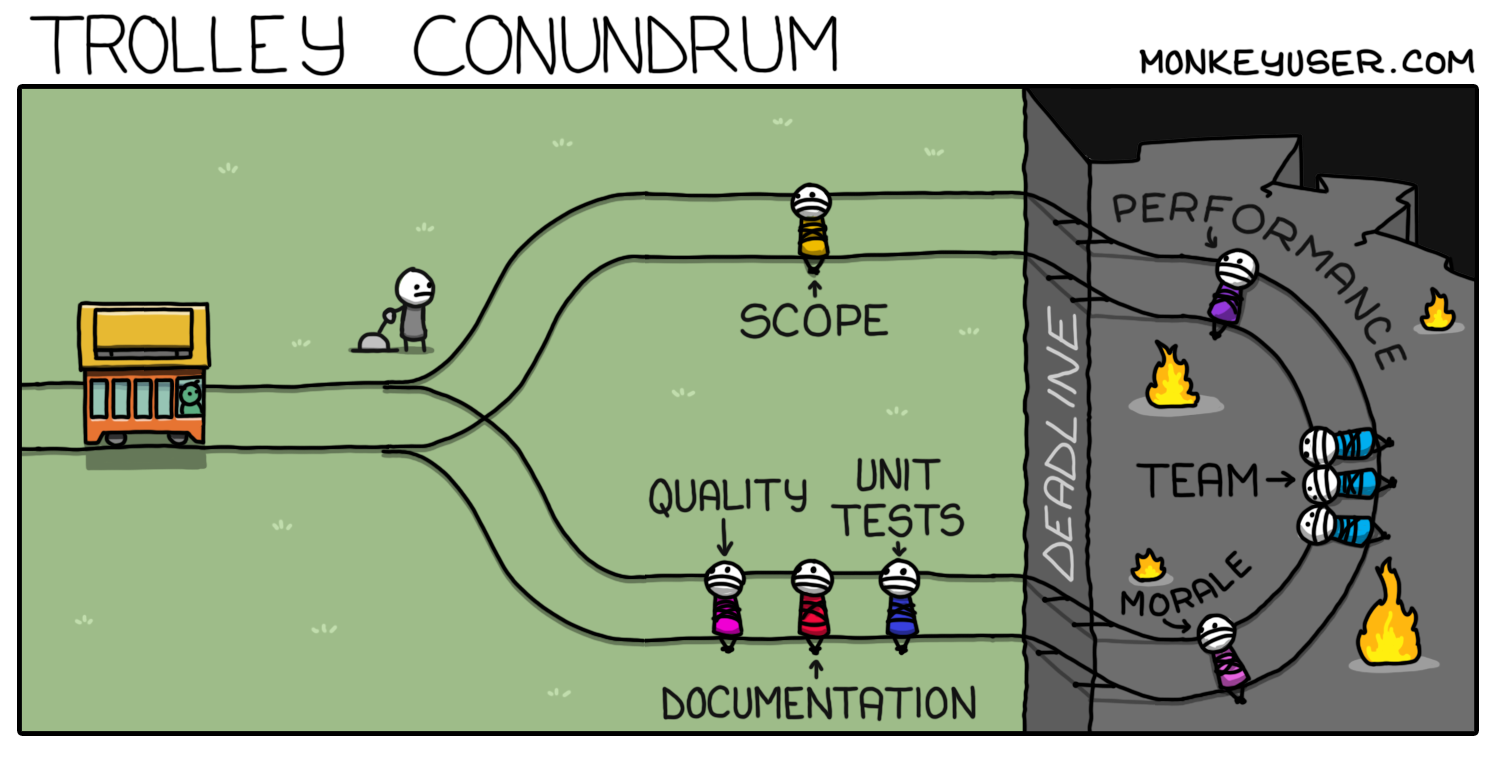Việc lập trình ít trực giác hơn nhưng lại có nhiều đánh đổi hơn các ngành khác
Khái niệm:: Đánh đổi, Trực giác
Đó chính là lý do Lập trình thực ra là dùng ẩn dụ, vì Ẩn dụ là cách ta hiểu code bằng cơ thể
Các ngành khác đều làm việc với những vật thể cụ thể trong không gian. Chỉ có ngành lập trình là không có điều đó
Khi đang dành tâm trí cho một công việc nhưng phải tạm hoãn giữa chừng để học một công cụ, ta sẽ không nhức đầu khi đó là công cụ vật lý, nhưng lại nhức đầu khi đó là công cụ số
Học lập trình nhức đầu hơn học các ngành khác vì nó có quá nhiều đánh đổi, đồng thời cũng kém tính vận động trong không gian hơn, nên ta ít có khả năng nảy sinh trực giác hơn
Mỗi loại công nghệ đều có những ưu, khuyết điểm trong những trường hợp nhất định (về yêu cầu, quy mô, nhân lực, timeline, bảo mật, ông lead, bà PM, vân vân mây mây…)
Các đánh đổi tạo ra nhiều tổ hợp giải pháp khác nhau cho cùng một nhu cầu
Những đánh đổi phổ biến trong việc phát triển phần mềm¶
Common challenges and trade-offs in Software design and architecture
As we know software development is a complex process that involves making decisions and trade-offs at various stages. Software architects and development teams often encounter trade-offs that require careful consideration and planning to make right balance to meet overall project objectives effectively.
In this post, we will list out some of the most common trade-offs encountered in software development.
Performance vs. Scalability¶
Performance and scalability are key considerations in software development. Performance focuses on optimizing response time and system efficiency for individual users. On the other hand, scalability involves designing systems that can handle increased workloads, users, and data volumes without sacrificing performance.
Striking the right balance between performance and scalability requires careful architectural choices, optimization techniques, and scalability strategies.
Flexibility vs. Complexity¶
Software flexibility refers to the ability to easily adapt and modify the software to meet changing requirements. On the other hand, complexity arises from incorporating advanced features and accommodating various use cases, potentially making the system harder to understand and maintain.
Balancing flexibility and complexity requires finding the right level of abstraction, modular design principles, and architectural patterns that allow for future modifications while keeping the system manageable.
Cost vs. Maintainability¶
Cost considerations play a significant role in software development. Balancing costs involves evaluating the financial investment required to develop and maintain the software. On the other hand, maintainability refers to designing software that is easy to manage, update, and fix, minimizing long-term costs.
Achieving the right balance requires considering factors such as development efforts, infrastructure costs, training, and ongoing maintenance to ensure a cost-effective and sustainable solution.
Development Speed vs. Code Quality¶
Development speed is often crucial to meet project deadlines or market demands. However, maintaining code quality is equally important to ensure a robust and maintainable software system.
Balancing development speed and code quality requires adopting agile development practices, automated testing, code reviews, and continuous integration and delivery processes. Striving for a balance between rapid development and code quality can result in a sustainable and efficient development workflow.
User Requirements vs. Technical Feasibility¶
User requirements reflect the desired functionality and features from the end-users’ perspective. However, technical feasibility considers the limitations and constraints imposed by available technologies and resources.
Balancing user requirements and technical feasibility requires effective communication with stakeholders, understanding trade-offs, and making informed decisions based on technological capabilities and limitations.
Customization vs. Standardization¶
Customization allows tailoring the software to specific user needs and preferences. However, standardization emphasizes adopting industry standards and best practices for interoperability, consistency, and maintainability.
Balancing customization and standardization involves understanding user requirements, identifying areas that can be standardized, and implementing customization options without compromising overall system stability and maintainability.
User Experience vs. Security¶
User experience (UX) is a key factor in software success, focusing on providing an intuitive and seamless interface for users. However, ensuring adequate security measures can introduce additional steps or constraints for users.
Striking a balance between UX and security involves implementing user-friendly security measures, conducting thorough risk assessments, and adopting industry best practices to maintain a balance between usability and protection of user data.
Innovation vs. Compatibility¶
Innovation is a driving force in software development, enabling the introduction of new features and technologies. However, ensuring compatibility with existing systems, browsers, or devices is equally important.
Balancing innovation and compatibility requires careful evaluation of the target audience, market trends, and the potential impact on users. Adopting backward compatibility strategies, conducting compatibility testing, and leveraging standardization can help mitigate risks and strike the right balance.
Performance vs. Resource Utilization¶
Performance optimization aims to deliver fast and efficient software execution. However, optimizing performance might increase resource utilization, such as memory or processing power.
Balancing performance and resource utilization involves fine-tuning algorithms, optimizing data structures, and utilizing caching mechanisms to achieve optimal performance while efficiently utilizing available resources.
Simplicity vs. Extensibility¶
Simplicity in software design promotes ease of understanding and maintenance. However, balancing simplicity and extensibility requires considering future enhancements and additions. Employing modular design principles, decoupling components, and following design patterns that allow for extension can strike a balance between simplicity and extensibility.
Conclusion¶
At different stages of software development, architects and development teams encountered some of the above trade-offs to to meet project objectives effectively. Understanding these trade-offs and finding the optimal balance is crucial for successful software delivery. Striking the right balance requires a holistic approach, considering project requirements, available resources, and stakeholder expectations. By consciously evaluating and managing trade-offs, software professionals can deliver successful software solutions that meet user needs while maintaining a balance between competing factors.
